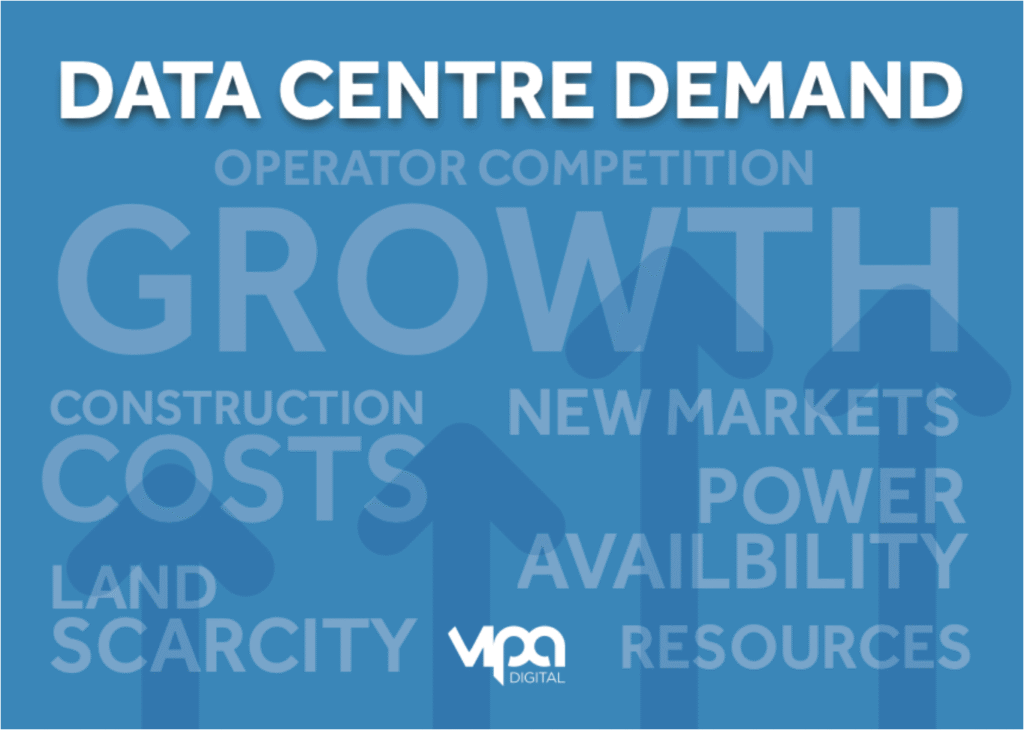Data Centre Demand

Why meeting Data Center demand is not a race to the bottom
[Also published in Techcapital Guest Blog: Stuart Hall 07/07/21T]
The commercial data centre sector is growing; analysts and trade press report record levels of new development, existing sites are expanding to accommodate new capacity and enterprise sites are being divested and redeployed by colocation providers. This is being driven by the relentless growth in demand for digital data, in turn due to digitisation of business, public services, media and entertainment, by e- commerce, by smart infrastructure and operations and by social preferences. Our economy is now digital and our economic success, now and in the future, depends on adequate capacity in mature, secure and efficient facilities, and on state of the art connectivity.
Cloud Growth
The majority of growth is being driven by large cloud service providers and is taking the form of large-scale wholesale contracts with relatively long term commitment, and more recently, build to suit. Up to a decade of guaranteed revenue at scale is obviously attractive to operators and investors and with only a few of these large customers in the market, competition is fierce. Speed is critical to meet the urgent demand for capacity and build schedules are exceptionally challenging. As a result, developers are obliged to comply with unusually harsh contractual conditions that under normal circumstances would never be countenanced. At the same time landowners have become increasingly aware that plots suitable for data centre development are relatively hard to come by and reflecting this in land prices. Local authorities and planners are also adding costly tariffs and conditions in Schedule 106* agreements.
So where does that leave Operators and Developers?
Are they being squeezed in the middle by rising costs on the one hand and punitive conditions on the other? Are providers being played off against each other and competing beyond their economic means in order to secure this long term business? Is the market becoming oligarchic, dominated by a few large players? Is data centre supply a race to the bottom?
The answer to these questions is largely “no”, and for good reason. The large cloud providers driving the majority of growth in the UK are themselves experienced data centre developers and operators. They build large scale facilities all over the world and are sophisticated customers, highly knowledgeable about what can and cannot be achieved. To date, their approach to the UK market is not to buy plots and develop facilities themselves as they do in Scandinavia and Ireland, but instead to lease space at scale from third parties or commission bespoke facilities known as build to suit. Over time this may change, but at the moment this is the dominant business model. This perhaps reflects the fact that currently, the UK represents a secondary market rather than a regional hub for these operators.
Cost Pressure
From the developer side, there are also factors preventing unsustainable downward pressure on prices. Developers know their build costs and there is an expected return on investment. They have a duty to their shareholders to demonstrate that returns are adequate and for larger operations, punitive pricing conditions would be rejected by investment committees. And,despitethesomewhatsecretivenatureof the industry, there is always a market price envelope and sales teams would soon sniff out anyone offering significant deviations outside this. Yes, there will be developers that offer lost leaders to secure the business, or less experienced companies prepared to offer below market rates, but unsustainable pricing brings increased project risk.
From the customer side, public-facing companies with reputations to protect will not push providers to breaking point. Their primary objective is the delivery of new capacity at speed, and in the UK and the European FLAP markets suitable land is scarce and there is shortage of inventory. What we have here in reality looks much more like a classic supply and demand dynamic where a race to the bottom is in nobody’s interests. Developers do need to protect themselves–firstly from the impact of increased land costs, development charges, taxes, levies and planning conditions can be hard to ascertain in advance and can eat away at profit margins. Costly transactional delays are increasingly likely now that data centre acquisitions are to be scrutinised under the National Security and Investment Bill. Secondly developers need to understand what they can and cannot push back on.
Availability of development sites remains one of the supply chain constraints that continue to hamper delivery programs in the popular European metro locations as resources, infrastructure and expertise are put under pressure or become exhausted. Investors, developers, operators and end-users are all too aware of pressure on cost and program in these locations. Collaboration between the various stakeholders often unlocks innovation not easily accessible to any single participant, with the impact of additional costs reflected in business plans that may ultimately fall short of investment criteria, requiring extension of the Real Estate search, value engineering and optimisation of the chosen location.
* Section 106 (S106) Agreements are legal agreements between Local Authorities and developers; these are linked to planning permissions and can also be known as planning obligations.